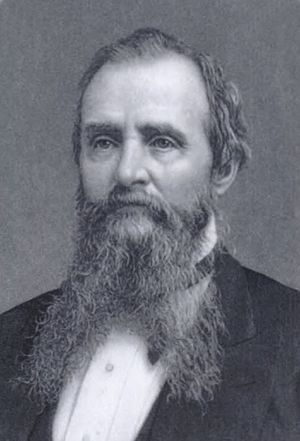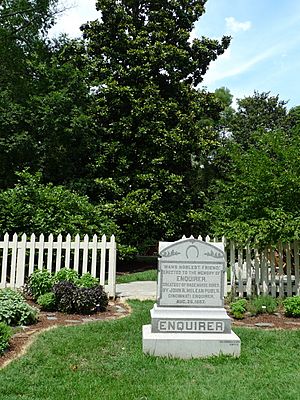Belle Meade Plantation facts for kids
Quick facts for kids |
|
|
Belle Meade Historic Site and Winery
|
|

Belle Meade Historic Site and Winery
|
|
| Location | 5025 Harding Pike Belle Meade, Tennessee |
|---|---|
| Built | 1807 |
| Architectural style | Greek Revival |
| NRHP reference No. | 69000177 |
| Added to NRHP | December 30, 1969 |
Belle Meade Historic Site and Winery is a famous old farm in Nashville, Tennessee. It was started in 1807 by the Harding family. For almost 100 years, five generations of the Harding-Jackson family owned and managed this large property.
The farm was called "Belle Meade," which means "beautiful meadow." At its biggest, it covered 5,400 acres (about 22 square kilometers). Many enslaved people worked on the farm, helping it grow. The main building was a grand mansion built in 1853 in the Greek Revival style.
Belle Meade became very well-known in the late 1800s for breeding fast thoroughbred racehorses. One of its most famous horses was a stallion named Iroquois. During the American Civil War, Union soldiers took over Nashville and stayed at the mansion. The owner was even put in prison for a while.
After the war, the farm slowly recovered. Many formerly enslaved people returned to work there as paid employees. However, after a financial crisis in 1893 and the deaths of the owner and his son, the large estate was sold off in pieces in 1906.
Today, much of the original land is part of the fancy City of Belle Meade. This area includes places like Cheekwood Botanical Gardens and Percy Warner Park. Since 1953, the mansion has been looked after by a group that works to save old places in Tennessee. In the 1970s, it was added to the National Register of Historic Places, which lists important historical sites.
Now, Belle Meade is a popular place to visit. It's a museum, a winery, and has a restaurant. Many of its original buildings are still there, like a dairy, a carriage house, and stables. The people who run Belle Meade also share the stories of the African Americans who lived and worked there, both before and after slavery ended.

Contents
The Mansion and Its Surroundings
Building Styles at Belle Meade
John Harding bought a small log cabin and 250 acres of land. Enslaved people began to clear the land and build homes for themselves. These homes were often two-family cabins.
In the 1820s, Harding had the first brick house built. It was in the Federal style and sat on a small hill. This house had a two-story front with five sections and two smaller wings on each side.
His son, William Giles Harding, took over Belle Meade in 1839. William G. Harding bought more land to raise high-quality animals, especially thoroughbred horses. He eventually owned 5,400 acres. In 1853, he changed and enlarged the house to the Greek Revival style. The red bricks were covered with stucco, and a two-story porch was added to the front. This porch had six large limestone pillars from Belle Meade itself.
A two-story kitchen was added to the house, connected by a covered walkway. This kept the heat from cooking away from the main living areas. Later, in the 1880s and 1890s, a dairy, a Carriage House, and a Stable were also built. William G. Harding also had a special building called a mausoleum built in 1839 for his family members.
Inside the Mansion
The main Entrance Hall is 14 feet high and runs through the middle of the house. It was designed this way to help keep the house cool with natural breezes. On the walls, you can see paintings of famous thoroughbred horses by artists from the 1800s.
On one side of the hall are two connected living rooms, called parlors. These rooms feature wood from the tulip poplar, which is Tennessee's state tree. On the other side are the library and dining rooms. These rooms have portraits of the Harding family and chandeliers that used to be lit by gas.
The second and third floors also have a central hall. A beautiful winding staircase, made of cherry wood, connects the floors. The second floor has several bedrooms. In 1883, William Hicks Jackson, who married Harding's daughter, updated the house. He added three full bathrooms with hot and cold running water. The third floor has two smaller rooms with 8-foot-high ceilings.
The mansion also has a cellar, which was unusual for the time. It held a steam engine and a boiler that provided hot and cold water for the house.
Belle Meade's Grounds Today
Today, Belle Meade's property covers 30 acres (about 120,000 square meters). There are 10 other buildings spread around the estate. This includes the original log cabin that John Harding bought in 1807. Harding added the Smokehouse in 1826, which grew to be the largest in the South. It could smoke up to 20,000 pounds of pork each year!
Other buildings added later by the Harding and Jackson families include:
- An 1870s Children's Playhouse, used by the Harding children.
- The 1884 Dairy, which made fresh milk, cream, cheese, and up to 240 pounds of butter every week.
- The 1892 Carriage and Stable House, which shows off the family's impressive collection of carriages.
A Visitors' Center was built in 1990. It's where guests arrive, buy tickets, and find the Gift Shop. In 2009, Belle Meade opened Nashville's first Winery. It makes red and white wines from local grapes like the muscadine, and also blackberry wine. There's also a restaurant called the Belle Meade Meat and Three, serving smoked meats and homemade desserts.
Belle Meade's Story
Starting the Farm
In 1807, Virginian John Harding bought a log cabin and 250 acres of land. This land was near the Natchez Trace, an old Native American path. He started a farm and called it "Belle Meade," meaning "beautiful meadow." Harding ran different businesses there, like a blacksmith shop and mills for cotton and wood.
By 1816, Harding was boarding horses for neighbors, including Andrew Jackson, who later became president. He also started breeding and racing his own thoroughbred horses. Middle Tennessee became famous for raising purebred animals. In 1823, Harding registered his racing colors with the Nashville Jockey Club.
Growth and the Civil War Years
William Giles Harding inherited Belle Meade in 1839. Over the next few decades, he bought more land, making the farm 5,400 acres large. Before the Civil War, 136 enslaved African Americans lived and worked at Belle Meade. In 1853, he made his father's house into the much larger mansion we see today.
When the American Civil War began in 1861, Harding had to stop his horse racing business. He strongly supported the Confederate States of America. He gave a lot of his own money and helped raise more for the Confederate Army. He was made a Brigadier General and put in charge of a factory making supplies for the war.
After Union forces took control of Nashville in April 1862, Harding was arrested. He was sent to prison in Michigan for six months. He was released after paying a large amount of money and promising to support the United States. He then stayed under house arrest at Belle Meade.
Confederate General James Chalmers used Belle Meade as his headquarters during the Battle of Nashville. On December 15, 1864, Union and Confederate soldiers fought near the family's racetrack.
After the War and Horse Breeding Fame
After the Civil War, Harding started his horse farm again, but with fewer workers. Of the 136 enslaved people who had been at Belle Meade, 72 chose to stay and work for pay. Most lived in homes off the property, but some stayed in cabins on the estate. Everyone who worked there as paid staff had to sign a contract with 18 rules.
In 1868, Harding's oldest daughter, Selene, married William Hicks Jackson. He had been a Confederate General. William G. Harding agreed to the marriage if the couple lived at Belle Meade. Selene managed the household, and Jackson helped his father-in-law run the farm.
In 1875, Harding and Jackson decided to stop racing horses and focus only on breeding them. They held yearly sales of young horses, sometimes at Belle Meade, and sometimes they took horses by train to New York. They made Belle Meade a nationally famous farm for thoroughbreds and other high-quality animals. The farm also sold ponies, cattle, sheep, and goats. It even had a 500-acre deer park.
Belle Meade had many successful male horses used for breeding, like Bonnie Scotland and Enquirer. Their bloodlines became very important in American horse racing. In 1886, Jackson bought the famous stallion Iroquois. Iroquois was the first American-bred thoroughbred to win the Epsom Derby in England in 1881. By 1892, he was considered the top breeding horse in the United States.
Jackson also enjoyed shooting birds. He gave land on the estate to build a shooting lodge and started the Belle Meade Gun Club in 1898. The club hosted a national shooting competition. Famous sharpshooter Annie Oakley even visited the club in 1899 for a special shooting event.
The End of an Era and Preservation
William Hicks Jackson died in 1903, and his adult son, William Harding Jackson, died later that same year from Typhoid fever. The farm faced money problems after a financial crisis in 1893. Also, baseball was becoming more popular than horse racing, and there was a movement against gambling linked to horse racing. Because of these issues, the estate's manager decided to sell Belle Meade in 1906.
A group called The Belle Meade Land Company bought a large part of the land. They planned to build a new neighborhood, also called "Belle Meade." In 1938, most of the old Belle Meade land became the independent city of Belle Meade, Tennessee.
The Mansion and 30 acres of land were saved by private owners. Five other families lived in the home until 1953. Then, the State of Tennessee bought the Mansion and eight other buildings to make sure they would be preserved. The state gave the property to a group called the Association for the Preservation of Tennessee Antiquities. This group now runs Belle Meade as a museum, attraction, winery, and restaurant. In the 1970s, it was added to the National Register of Historic Places.









